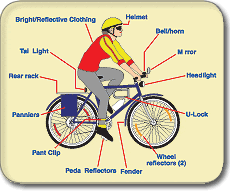Proper Gear and Practices
• A proper helmet can reduce head injuries by about 85 percent. Always wear a helmet with a label stating that it meets the Consumer Product Safety Commission standard. Select a helmet that fits snugly and sits flat on your head. Discard a helmet after it sustains a blow. Even a slight blow can affect impact absorbing foam.
• Take a safety course. One organization offering courses for all ages is the League of American Bicyclists at (202) 822-1333.
• Know and obey traffic regulations, signs, signals, and markings.
• Ride a bicycle that “fits” your body and riding needs. Learn about the proper fit for your style of bike in our “Detailed Info About Bicycle Types” section.
• Before riding, make sure all the parts are secure and working properly. Check your brakes before stepping onto your bicycle and keep them properly adjusted.
• Wear bright or fluorescent clothing during the day. Be more visible by flying an orange flag from the back of your bike.
• Never wear headphones.
• Use a rear view mirror.
Take A Balanced Approach
• Find a safe place to ride. Many cities or bicycle clubs have maps of recommended routes.
• Cycle defensively. More than 70 percent of bicycle accidents involving cars occur at driveways or intersections. Expect a car to pull out from a side street, or turn left in front of you.
• If traffic is heavy, walk your bike across an intersection.
• Make eye contact with drivers and signal your intentions.
• Cycle with the flow of traffic, and never against it.
• In a group, it’s best to ride single file, unless you are off the road, or on quiet, secondary roads.
• Don’t carry passengers or items that interfere with control of the bike.
• Stay alert at all times. Look out for hazardous surfaces or obstacles in your path, such as potholes, loose gravel, manhole covers, cracks, railroad tracks, or wet leaves.
• Leave at least three feet of distance when passing parked cars so opened doors don’t cause a crash.
• Be predictable. Maintain a straight line when you’re cruising your bike.
• Stay at least three feet to the right of cars if you can. If there is a wide, clean shoulder, use it.
• Watch for pedestrians, especially kids or animals that might dart in front of you. If a dog chases you, stop and dismount, then use your bike as a shield.
• Before turning, look back, check all directions for traffic, and use hand signals.
• Avoid provocative actions that might irritate drivers.
• When in danger, shout!
• The bike will be less stable with a child in a seat. A cart towed by a bike is far safer. Plan to go slower, take turns gently, and avoid busy streets.
• Carry loads at the rear of the bike in cases designed for bicycles.
Riding After Dark
• Avoid biking at night if possible. It is far more dangerous than riding during the day. Most bicycles need to be adapted for nighttime use.
• Add the brightest lights and largest reflectors you can find to the front and rear or your bicycle.
• Wear reflective clothing or material, especially on your ankles, wrists, back, and helmet. White or fluorescent are not good enough.
• Ride only in familiar areas. Streets with bright lighting are best.
• Always assume that a driver does not see you.
